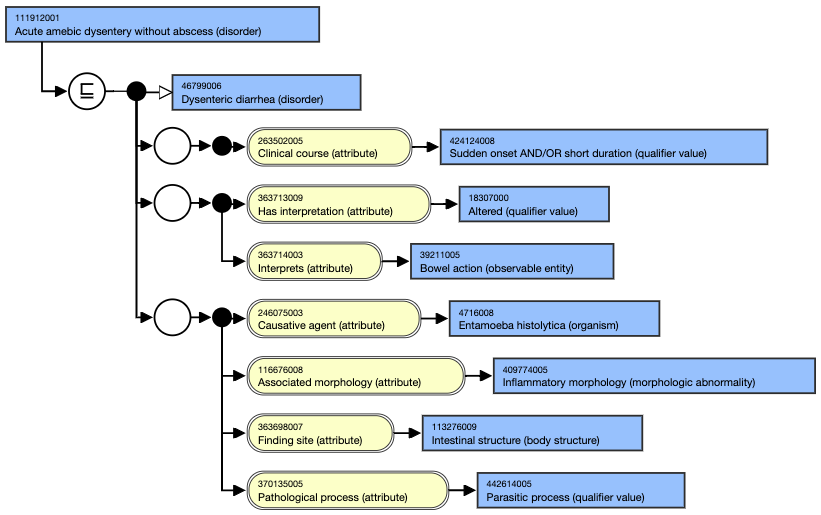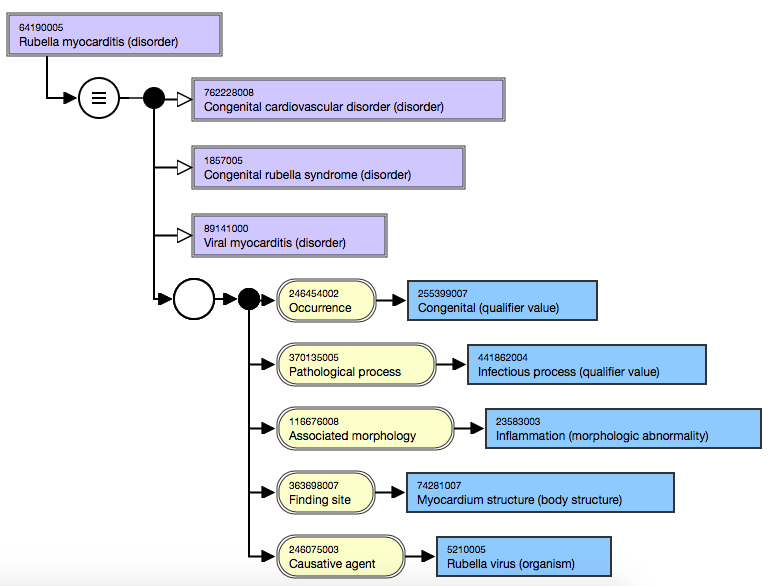...
- The Finding site (attribute) and Associated morphology (attribute) are always grouped when both are present and related.
- When there is more than one Finding site (attribute) or Associated morphology (attribute), then more than one relationship group is required.
- When the attributes Occurrence and/or Causative agent are stated and related to the Finding site and Associated morphology attributes, include them within that relationship group.
- As in the following diagram, when the Causative agent (attribute) is an organism, the Pathological process (attribute) is also included in that relationship group, with the target value of either
| Concept |
|---|
| t | 441862004 |Infectious process (qualifier value)| |
|---|
|
or | Concept |
|---|
| t | 442614005 |Parasitic process (qualifier value)| |
|---|
|
.
- If a concept has values for a Causative agent (attribute) and Finding site (attribute), but does not have a value for an Associated morphology (attribute) or Pathological process (attribute), combine the Causative agent (attribute) and Finding site (attribute) as usual. Concepts that only have Causative agent (attribute) and Finding site (attribute) in a role group are higher in the hierarchy and subsume those concepts that have a role group of Causative agent (attribute), Finding site (attribute), Associated morphology (attribute) and Pathological process (attribute).
- The Interprets and Has interpretation attributes are always grouped together where both are present and related to each other. These two attributes and their values are often used in defining a Clinical finding concept by delineating the observation results or describing the analysis used to determine the observation. Interprets and Has interpretation attributes are not grouped with any other attributes.
- The Finding method and Finding informer attributes are also grouped together where both are present and related to each other.
| Tip |
|---|
| title | Relationship group clarification |
|---|
|
A relationship group that uses the attributes Associated with, Before, During, After, Due to, Clinical course, or Temporally related to are not grouped with another attribute-value pair; these attributes are "self-grouped". This means, authors place these attributes in a relationship group individually with no other attributes. - Note: 726633004 |Temporally related to (attribute)| only applies to perioperative procedures and to a limited number of clinical findings.
|

| Caption label |
|---|
| CapId | stated-view-of-a-disorder-hierarchy-concept-with-causative-agent-and-pathological-process-attribute-value-pairs-in-the-same-relationship-group |
|---|
| CapType | Figure |
|---|
|
Stated view of a disorder hierarchy concept with Causative agent and Pathological process attributes in the same relationship group |

Situation with Explicit Context hierarchy
For
| Concept |
|---|
| t | 413350009 |Finding with explicit context (situation)| |
|---|
|
concepts, the following four attributes are grouped:
| Concept |
|---|
| t | 408729009 |Finding context (attribute)| |
|---|
|
| Concept |
|---|
| t | 246090004 |Associated finding (attribute)| |
|---|
|
| Concept |
|---|
| t | 408731000 |Temporal context (attribute)| |
|---|
|
| Concept |
|---|
| t | 408732007 |Subject relationship context (attribute)| |
|---|
|
For example,
| Concept |
|---|
| t | 704008007 |No family history of asthma (situation)| |
|---|
|
IS A | Concept |
|---|
| t | 243796009 |Situation with explicit context (situation)| |
|---|
|
,| Concept |
|---|
| t | 408729009 |Finding context (attribute)| |
|---|
|
, | Concept |
|---|
| t | 410516002 |Known absent (qualifier value)| |
|---|
|
| Concept |
|---|
| t | 246090004 |Associated finding (attribute)| |
|---|
|
, | Concept |
|---|
| t | 195967001 |Asthma (disorder)| |
|---|
|
| Concept |
|---|
| t | 408731000 |Temporal context (attribute)| |
|---|
|
, | Concept |
|---|
| t | 410511007 |Current or past (actual) (qualifier value)| |
|---|
|
| Concept |
|---|
| t | 408732007 |Subject relationship context (attribute)| |
|---|
|
, | Concept |
|---|
| t | 444148008 |Person in family of subject (person)| |
|---|
|
For
| Concept |
|---|
| t | 129125009 |Procedure with explicit context (situation)| |
|---|
|
concepts the following four attributes are grouped:
| Concept |
|---|
| t | 408730004 |Procedure context (attribute)| |
|---|
|
| Concept |
|---|
| t | 363589002 |Associated procedure (attribute)| |
|---|
|
| Concept |
|---|
| t | 408731000 |Temporal context (attribute)| |
|---|
|
| Concept |
|---|
| t | 408732007 |Subject relationship context (attribute)| |
|---|
|
For example,
| Concept |
|---|
| t | 704503005 |Advice given about pelvic floor exercise (situation)| |
|---|
|
IS A | Concept |
|---|
| t | 129125009 |Procedure with explicit context (situation)| |
|---|
|
| Concept |
|---|
| t | 408730004 |Procedure context (attribute)| |
|---|
|
, | Concept |
|---|
| t | 385658003 |Done (qualifier value)| |
|---|
|
| Concept |
|---|
| t | 363589002 |Associated procedure (attribute)| |
|---|
|
, | Concept |
|---|
| t | 420227002 |Recommendation to (procedure)| |
|---|
|
| Concept |
|---|
| t | 408731000 |Temporal context (attribute)| |
|---|
|
, | Concept |
|---|
| t | 410512000 |Current or specified time (qualifier value)| |
|---|
|
| Concept |
|---|
| t | 408732007 |Subject relationship context (attribute)| |
|---|
|
, | Concept |
|---|
| t | 125676002 |Person (person)| |
|---|
|
...
When defining | Concept |
|---|
| t | 363787002 |Observable entity (observable entity)| |
|---|
|
concepts, attributes are self- grouped. Each observable entity represents only one property being observed. For example, | Concept |
|---|
| t | 400975005 |Standing diastolic blood pressure (observable entity)| |
|---|
|
is is represented using multiple attributes with each in its own within one relationship group.
 Image Removed
Image Removed Image Added
Image Added
| Caption label |
|---|
| CapId | stated-view-of-a-concept-from-the-observable-entity-hierarchy-with-self-grouped-attributes |
|---|
| CapType | Figure |
|---|
|
Stated view of a concept from the Observable entity hierarchy with self-grouped attributes |



